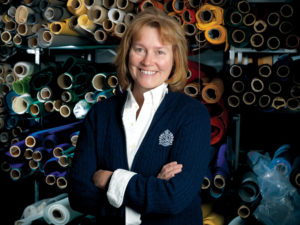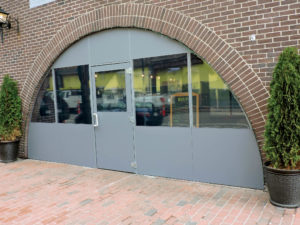Cheryl Yennaco rebuilds a business by making the tough decisions, hiring the right team and setting meaningful and measurable goals.

“Last year was our best year, and we’re at another point of growth right now,” says Cheryl Yennaco, owner and general manager of Melrose, Mass.-based Atlantic Awnings. “That growth started when we decided to clean house and rebuild the business. It wasn’t easy but it was worth it, and at this moment we have the best team we’ve ever had.”
Yennaco is a third-generation awning shop owner, starting with her grandfather who owned Boston Awning with three partners. She grew up around awnings, working with her father at a company that he owned with his brother. While Atlantic Awning has been around since 1888, her family’s involvement in the company began in 1981 when her father purchased the shop.
First working with her father and uncle at their shop and then at Atlantic Awning, Yennaco continued to increase her hours during summers and time off from school, and started working full-time at Atlantic Awning after graduating from college with a major in business management. “It was always the plan that I would work at the company,” she says. “I graduated on a Saturday and started full-time the following Monday.”
At the top of Yennaco’s list of goals was to attend her first IFAI Expo, which took place in Orlando, Fla. “I told my dad I was going but he advised me against it, saying it wasn’t a place for a woman by herself,” she says. “But I was determined to go, and he finally relented, with the condition that he and my mom accompany me.”
It had been a few years since Yennaco’s father had attended a show, and to his surprise, more women were in attendance than he’d expected. “From that point on, he was comfortable with me going myself,” she says. “I was planning to keep going anyway. I believed it was important to be involved in the industry in that way. And I still believe that.”
In with the new
When Yennaco and her husband Mark Horton purchased Atlantic Awning three years ago, it was a rocky transition. The once-successful business had been having some difficulties, but again Yennaco was determined—and this time her determination was focused on doing whatever was necessary to rebuild the company. Horton quit his job as an electrical engineer and the two began making the difficult decisions necessary to accomplish their goals.
It took a while to come to the decision that letting long-time staff go was necessary. Yennaco says her accountant and attorney had been advising her to clean house for quite a while before she decided to take action. “My gut told me from day one that’s what I needed to do, but it’s hard to let go of someone who’s been there for 40 years,” she says. “It was really tough. After we took over, we found that the staff didn’t look up to me and my husband. They would come in late, leave early and would make mistakes, but didn’t seem to care.”
Hiring mostly new staff was no easy feat either. “This past year has been like a revolving door around here,” Yennaco says. “But one reason for that is that I don’t wait to make the tough decision to let someone go if I know it’s not going to work out. I can usually tell in a week or two if they’re not going to be a good fit.”
Getting—and keeping—the right people is now a non-negotiable philosophy for Yennaco and Horton, and making the decision to let an employee go sooner rather than later is a key part of their approach. “The longer you wait, the more detrimental it is to everyone,” she says. “Customers aren’t happy because the work isn’t getting done properly the first time. You aren’t happy because you have to re-do work and you’ve lost money. It’s hard as heck to let employees go, but you have to have the right people on the bus.”
Easing the growing pains
 The challenge with having almost all new staff, Yennaco says, is that while some have more experience than others, they’re all new to Atlantic Awning. “We have a handful of people in training, but we don’t have enough people who are experienced that can help with that,” she says. “At the moment the crew can’t produce fast enough to keep up with orders, so we’re a bit backlogged. But more importantly, the staff is energetic and willing to move forward and build the company together.”
The challenge with having almost all new staff, Yennaco says, is that while some have more experience than others, they’re all new to Atlantic Awning. “We have a handful of people in training, but we don’t have enough people who are experienced that can help with that,” she says. “At the moment the crew can’t produce fast enough to keep up with orders, so we’re a bit backlogged. But more importantly, the staff is energetic and willing to move forward and build the company together.”
Among the strategies Yennaco has for closing that gap is implementing a software management system, and creating checklists and more standard operating procedures (SOPs). She is currently using a software management system created for the sign industry, and while it’s not intended for the awning industry, she says it’s helpful. “It has a CRM (customer relationship management), production flow and calendars, which will be a huge help,” she says. “It’s got some quirks, of course, because it’s not built for awnings. I wish there was something out there for the awning industry, but I don’t know of anything available yet—and it’s expensive to customize a system.”
Every couple of months Yennaco and Horton write a new SOP for the staff. “There are so many little pieces of the business, sometimes you just shake your head,” she says. “Creating SOPs and making an effort to meet on a regular basis with staff is helping keep us on the same page … when we’re not too caught up in the day-to-day,” she adds.
The crew uses checklists as reminders for those things that may seem obvious to someone who’s been working in the business for a long time but still need to become habits for newcomers. “For instance, when you put up an awning over someone’s door you need to open up the door to make sure it doesn’t hit the awning,” Yennaco says. “Those are the common-sense things you can forget when you’re new.”
The magic of three
Early on in Yennaco’s career she developed the habit of setting three goals when she’s looking to move the business forward (which, incidentally, is all the time). When she attends trade shows she’s found having goals in mind is particularly helpful. “This past year at IFAI Expo one of my goals was to talk to other people about what words they use on their websites as SEOs,” she says. “I also asked people how they’ve managed growth, and what advice they might have for us for the stage of growth we’re at now.”
As her career in the awning industry has progressed, Yennaco says she’s found ways to embrace change. “Being willing to change to make improvements is a big feat for me,” she says. “I don’t particularly like change, but we have changed the quality of our business and the quality of our products. I’m proud of that.”
- Seek opinions from trusted, experienced advisors.
- Be willing to change, and expect the transition to be challenging at first.
- Evaluate staff and let employees go who aren’t in line with your expectations.
- Set incremental goals for adding systems and honing workflow.
- Align with industry organizations. It’s a way to influence the industry while receiving support for your business.
 In the past five years Atlantic Awning has seen a noticeable increase in the interest and purchase of portable vestibule enclosures in the Greater Boston area and throughout New England. Mostly aimed at restaurants and other high-traffic food service markets, this product line has been a growing part of the company’s business. “Small quaint restaurants in older New England buildings have been plagued by the fact that much of their limited seating is exposed to the chilling winds of our Northeast winters, highly affecting their patrons’ comfort during the winter months” says Cheryl Yennaco, owner and general manager. “Our removable vestibules provide a much-needed answer to making use of the available space in many of these unique building configurations.”
In the past five years Atlantic Awning has seen a noticeable increase in the interest and purchase of portable vestibule enclosures in the Greater Boston area and throughout New England. Mostly aimed at restaurants and other high-traffic food service markets, this product line has been a growing part of the company’s business. “Small quaint restaurants in older New England buildings have been plagued by the fact that much of their limited seating is exposed to the chilling winds of our Northeast winters, highly affecting their patrons’ comfort during the winter months” says Cheryl Yennaco, owner and general manager. “Our removable vestibules provide a much-needed answer to making use of the available space in many of these unique building configurations.”
The vestibules provide an added windbreak to existing entrances as well as a necessary barrier from piled snow, such as the entrance Atlantic Awning installed in January 2017 at Mystic Station Eatery and Bar in Malden, Mass. The steel door is wrapped to match the side panels, and features heavy-duty industrial hinges, door closers and push/pull sets to give it a classic look, while providing a functional entrance in high-traffic areas. “The beauty of the product is the integration of the strength of steel and the softness of fabric,” Yennaco says. “The eloquence of fabric is combined with the utility of robust doors and wind/weather panels, while maintaining a panelized configuration for easy installation, dismantling and storage.”
As a board member of the Professional Awning Manufacturers Association (PAMA) and the North East Canvas Products Association (NECPA), what do you wish people understood about awnings?
Awnings are energy-saving products—for both business and residential structures. I think we as an industry could do a better job of marketing them. The United States is still far behind Europe in its understanding
of how we can use awnings.
How do you approach the hiring process?
The way I look at hiring is that it has to benefit the person I’m hiring as well as the business. Of course I’m looking for people who will do their jobs well and help move the business forward, but it’s also important to me to give people a better life.
Currently we’re adding positions, but what exactly the responsibilities of the new hires will be is a work in progress. I posted on Craigslist for three positions: sales, a crew member for on the road, and someone who would fill multiple roles—perhaps graphics and sales. It remains to be seen how we’ll move forward or if we’ll even hire all three positions. My strategy is to put all our needs out there and see who comes through the door.
 TEXTILES.ORG
TEXTILES.ORG


